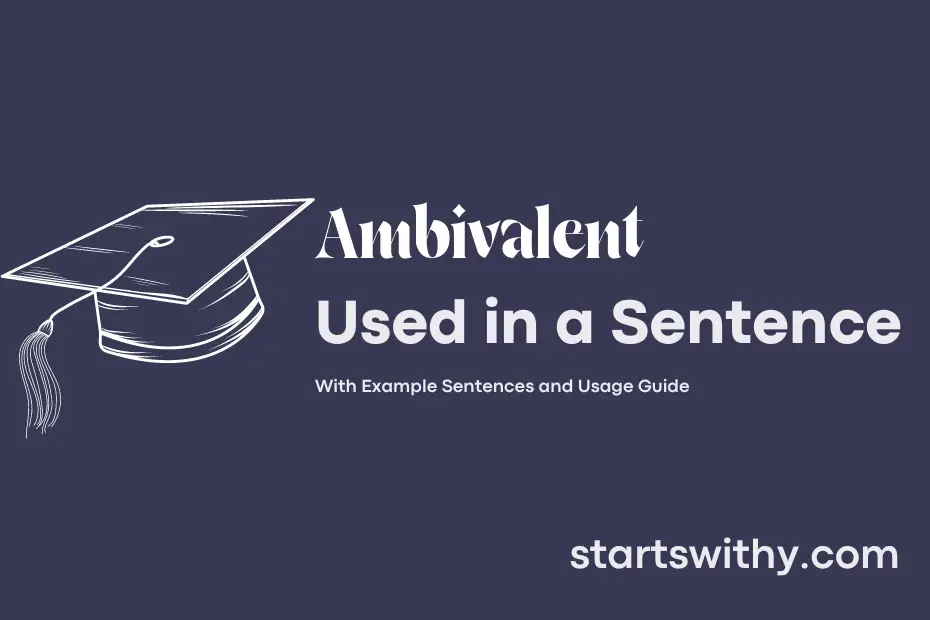Do you ever find yourself torn between conflicting emotions or opinions about something? If so, you may be experiencing ambivalence. Ambivalence refers to the state of having mixed feelings or contradictory attitudes towards a person, object, or situation.
This complex emotional state can manifest as feelings of uncertainty, hesitation, or indecisiveness. People often struggle with ambivalence when they are faced with difficult choices or when there are both positive and negative aspects to consider. Engaging with conflicting emotions can present challenges in decision-making and may lead to internal discord.
7 Examples Of Ambivalent Used In a Sentence For Kids
- Ambivalent means feeling unsure or having mixed feelings about something.
- Sometimes we may feel ambivalent when we can’t decide if we like something or not.
- It’s okay to be ambivalent, it’s normal to feel that way sometimes.
- When you are ambivalent, it’s important to talk to someone about how you feel.
- If you are feeling ambivalent, it’s okay to take your time to make a decision.
- Remember, everyone can feel ambivalent about things at some point.
- It’s important to trust your feelings, even if you are feeling ambivalent about something.
14 Sentences with Ambivalent Examples
- Ambivalent about whether to join a student club or focus solely on academics.
- Feeling ambivalent about choosing a major that aligns with passion or one with better job prospects.
- Ambivalent about attending a networking event, unsure if it will be beneficial or just a waste of time.
- Contemplating internship offers, but remaining ambivalent about which one to accept.
- Ambivalent about joining a protest on campus, considering the potential consequences.
- Feeling ambivalent about participating in a study abroad program, uncertain about being away from home for an extended period.
- Ambivalent about taking on a leadership role in a student organization, unsure if it will be too time-consuming.
- Struggling with being ambivalent about pursuing higher education immediately after completing undergraduate studies.
- Feeling ambivalent about seeking help from a counselor for academic stress, concerned about the stigma associated with mental health.
- Ambivalent about using social media to connect with classmates for group projects, debating the effectiveness of online communication.
- Feeling ambivalent about attending a career fair, questioning if it will truly benefit in securing a job after graduation.
- Ambivalent about choosing between a part-time job or focusing solely on academics during the semester.
- Considering starting a side hustle but remaining ambivalent about balancing it with college responsibilities.
- Ambivalent about participating in extracurricular activities, weighing the benefits of personal growth against the time commitment.
How To Use Ambivalent in Sentences?
Ambivalent is used to express conflicting feelings or attitudes towards something. To use ambivalent in a sentence, you can say:
“I am feeling ambivalent about the job offer because it comes with a higher salary but involves long hours.”
In this sentence, the word ambivalent is used to show that the speaker has mixed feelings about the job offer. They feel both positive and negative emotions towards the opportunity.
Another example can be:
“She was ambivalent about going on the vacation as she was excited to relax by the beach but reluctant to leave her pets at home.”
Here, the word ambivalent is used to convey the conflicting emotions the person has about going on vacation. They feel both eager and hesitant about the idea.
Remember, when using ambivalent in a sentence, make sure the context makes it clear that the individual is experiencing mixed emotions. It’s a word that indicates uncertainty or indecision, so it’s important to convey that in the sentence for it to make sense.
Conclusion
In conclusion, sentences with ambivalent feelings suggest a sense of uncertainty or conflicting emotions. These sentences often convey mixed opinions or hesitations, leaving the reader to interpret the underlying message. By using language that expresses ambiguity or dual perspectives, writers can add complexity and depth to their writing, engaging the audience in a different way. Whether expressing indecision, conflicting emotions, or complex viewpoints, sentences with ambivalent tones offer a nuanced portrayal of the human experience.
By mastering the art of crafting sentences with ambivalent sentiments, writers can elicit thought-provoking responses and create a more nuanced portrayal of characters, themes, or situations in their work. Embracing ambiguity in language adds layers of depth and complexity, inviting readers to engage with the text on a deeper level and fostering a richer understanding of the nuances of human emotion and experience.



